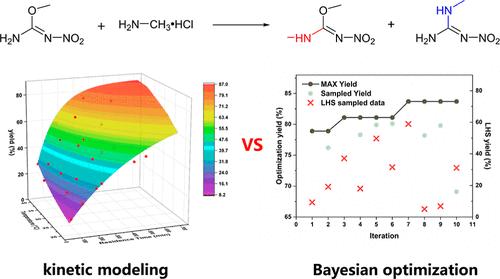当前位置:
X-MOL 学术
›
Ind. Eng. Chem. Res.
›
论文详情
Our official English website, www.x-mol.net, welcomes your
feedback! (Note: you will need to create a separate account there.)
Continuous Flow Synthesis of N,O-Dimethyl-N′-nitroisourea Monitored by Inline Fourier Transform Infrared Spectroscopy: Bayesian Optimization and Kinetic Modeling
Industrial & Engineering Chemistry Research ( IF 3.8 ) Pub Date : 2024-05-30 , DOI: 10.1021/acs.iecr.4c01003 Jiapeng Guo 1 , Guihua Luo 1 , Kejie Chai 1 , Weike Su 1 , An Su 2
Industrial & Engineering Chemistry Research ( IF 3.8 ) Pub Date : 2024-05-30 , DOI: 10.1021/acs.iecr.4c01003 Jiapeng Guo 1 , Guihua Luo 1 , Kejie Chai 1 , Weike Su 1 , An Su 2
Affiliation

|
The synthesis of N,O-dimethyl-N′-nitroisourea, crucial intermediates in pesticide manufacturing, was explored through a substitution reaction between O-methyl-N-nitroisourea and methylamine within a novel continuous flow microreactor system, featuring Fourier transform infrared (FTIR) in-line analysis for real-time monitoring. In this paper, the reaction is investigated using two optimization methods: the contemporary machine learning-based Bayesian optimization and the traditional kinetic modeling. Remarkably, both strategies obtained a similar yield of approximately 83% under equivalent reaction parameters─specifically, an initial reactant concentration of 0.2 mol/L, a reaction temperature of 40 °C, a molar ratio of reactants at 5:1, and a residence time of 240 min. The Bayesian optimization method demonstrated a notable efficiency, achieving optimal conditions within a mere 20 experiments, in contrast to the kinetic modeling approach, which required a more laborious effort for model formulation and validation. However, kinetic modeling allows for a more comprehensive understanding of the reaction, and the two optimization methods fully demonstrate their respective strengths and weaknesses. This study not only highlights the potential of integrating advanced machine learning methods into chemical process optimization but also sets the stage for further exploration into efficient, data-driven approaches in chemical synthesis.
中文翻译:

通过在线傅里叶变换红外光谱监测 N,O-二甲基-N'-硝基异脲的连续流动合成:贝叶斯优化和动力学建模
通过 O-甲基-N-硝基异脲和甲胺在新型连续流微反应器系统中的取代反应,探索了农药生产中关键中间体 N,O-二甲基-N'-硝基异脲的合成,该系统具有傅里叶变换红外(FTIR)技术。 )实时监控的在线分析。在本文中,使用两种优化方法研究反应:当代基于机器学习的贝叶斯优化和传统的动力学建模。值得注意的是,两种策略在相同的反应参数下均获得了大约 83% 的相似产率——具体来说,初始反应物浓度为 0.2 mol/L、反应温度为 40 °C、反应物摩尔比为 5:1 和停留时间时间240分钟贝叶斯优化方法表现出显着的效率,只需 20 次实验即可实现最佳条件,而动力学建模方法则需要更加费力的模型制定和验证工作。然而,动力学建模可以更全面地了解反应,两种优化方法充分展示了各自的优缺点。这项研究不仅凸显了将先进的机器学习方法整合到化学过程优化中的潜力,而且为进一步探索高效、数据驱动的化学合成方法奠定了基础。
更新日期:2024-05-30
中文翻译:

通过在线傅里叶变换红外光谱监测 N,O-二甲基-N'-硝基异脲的连续流动合成:贝叶斯优化和动力学建模
通过 O-甲基-N-硝基异脲和甲胺在新型连续流微反应器系统中的取代反应,探索了农药生产中关键中间体 N,O-二甲基-N'-硝基异脲的合成,该系统具有傅里叶变换红外(FTIR)技术。 )实时监控的在线分析。在本文中,使用两种优化方法研究反应:当代基于机器学习的贝叶斯优化和传统的动力学建模。值得注意的是,两种策略在相同的反应参数下均获得了大约 83% 的相似产率——具体来说,初始反应物浓度为 0.2 mol/L、反应温度为 40 °C、反应物摩尔比为 5:1 和停留时间时间240分钟贝叶斯优化方法表现出显着的效率,只需 20 次实验即可实现最佳条件,而动力学建模方法则需要更加费力的模型制定和验证工作。然而,动力学建模可以更全面地了解反应,两种优化方法充分展示了各自的优缺点。这项研究不仅凸显了将先进的机器学习方法整合到化学过程优化中的潜力,而且为进一步探索高效、数据驱动的化学合成方法奠定了基础。






























 京公网安备 11010802027423号
京公网安备 11010802027423号